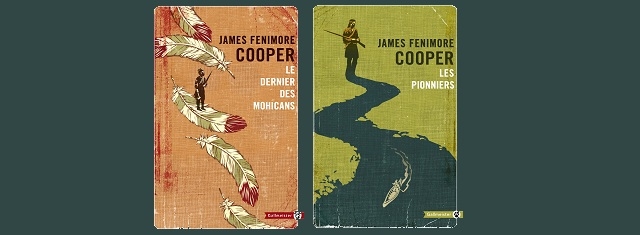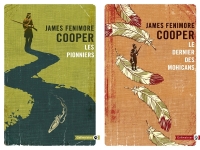Vips
JAMES FENIMORE COOPER - First Major American Novelist
Adventures Called LEATHERSTOCKING TALES

(Source: Gallmeister Editions)
USPA NEWS -
James Fenimore Cooper, (September 15, 1789 - September 14, 1851) is the First Major American Novelist, Author of the Novels of Frontier Adventure known as the "Leatherstocking Tales", featuring the Wilderness Scout called Natty Bumppo, or Hawkeye. They include The Pioneers (1823), The Last of the Mohicans (1826), The Prairie (1827), The Pathfinder (1840), and The Deerslayer (1841).
James Fenimore Cooper, (September 15, 1789 - September 14, 1851) is the First Major American Novelist, Author of the Novels of Frontier Adventure known as the "Leatherstocking Tales", featuring the Wilderness Scout called Natty Bumppo, or Hawkeye. They include The Pioneers (1823), The Last of the Mohicans (1826), The Prairie (1827), The Pathfinder (1840), and The Deerslayer (1841).
- "LES PIONNIERS" (The Pionneers) by James Fenimore Cooper and published in FRANCE by Gallmeister Editons. This Book (first published in Two Volumes in 1823) is the First of Five Novels in the Series The Leatherstocking Tales. It began the Saga of Frontiersman Natty Bumppo, also called Leather-Stocking. The Story takes place on the rapidly Advancing Frontier of New York State and features an Elderly Leatherstocking (Natty Bumppo), Judge Marmaduke Temple of Templeton and Elizabeth Temple, Daughter of the Fictional Templeton. The Story begins with an Argument between the Judge and Leatherstocking over who killed a Buck.
- "LES PIONNIERS" (The Pionneers) by James Fenimore Cooper and published in FRANCE by Gallmeister Editons. This Book (first published in Two Volumes in 1823) is the First of Five Novels in the Series The Leatherstocking Tales. It began the Saga of Frontiersman Natty Bumppo, also called Leather-Stocking. The Story takes place on the rapidly Advancing Frontier of New York State and features an Elderly Leatherstocking (Natty Bumppo), Judge Marmaduke Temple of Templeton and Elizabeth Temple, Daughter of the Fictional Templeton. The Story begins with an Argument between the Judge and Leatherstocking over who killed a Buck.
Through their Discussion, James Fenimore Cooper reviews many of the Changes to New York's Lake Otsego and its Area. Leatherstocking and his Closest Friend, the Mohican Indian Chingachgook, begin to compete with the Temples for the Loyalties of a Mysterious Young Visitor, a "Young Hunter" known as Oliver Edwards. The Latter eventually marries Elizabeth Temple. The Story focuses on the Development of a "Wilderness" Area as a Settled European-American Community with Refinements. Although not classified as a Naturalist Novel, James Fenimore Cooper depicts many Naturalist Based Ideas in "The Pioneers". His Use of Language, Dialogue and Description help to convey this Movement within this Novel.
- "LE DERNIER DES MOHICANS" (The Last Of The Mohicans) by James Fenimore Cooper and published in FRANCE by Gallmeister Editions. It is the Second Book of the "Leatherstocking Tales" Pentalogy and the Best Known to Contemporary Audiences. Its Principal Character is Natty Bumppo now in Middle Life and at the Height of his Powers. The Story tells of Brutal Battles with the Iroquois and their French Allies, Cruel Captures, Narrow Escapes, and Revenge. The Pivotal Set Piece is the Massacre at Fort William Henry during the French and Indian War. This is the “Factual“ Event around which Jameqs Fenimore Cooper builds a Compelling Tale of Wilderness Adventure.
Those Two Books were followed by "The Prairie" (1827) in which, now Very Old and Philosophical, Leatherstocking dies, facing the Westering Sun he has so long followed. James Fenimore Cooper intended to bury Leatherstocking in "The Prairie", but many years later he resuscitated the Character and portrayed his Early Maturity in "The Pathfinder" (1840) and his Youth in "The Deerslayer" (1841). These Novels, in which Natty becomes the Centre of Romantic Interest for the First Time, carry the Idealization Process further. In "The Pathfinder" he is explicitly described as an American Adam, while in "The Deerslayer" he demonstrates his Fitness as a Warrior-Saint by passing a Series of Moral Trials and revealing a Keen, though Untutored, Aesthetic Sensibility.... The “Leatherstocking“ Tales are Cooper´s Great Masterpiece, but he continued to write Many Other Volumes of Fiction and Nonfiction.
Ruby BIRD
http://www.portfolio.uspa24.com/
Yasmina BEDDOU
http://www.yasmina-beddou.uspa24.com/
Ruby BIRD
http://www.portfolio.uspa24.com/
Yasmina BEDDOU
http://www.yasmina-beddou.uspa24.com/
Ruby Bird Yasmina Beddou James Fenimore Cooper The Pioneers 1823 The Last Of The Mohicans 1826 Editions Gallmeister
Liability for this article lies with the author, who also holds the copyright. Editorial content from USPA may be quoted on other websites as long as the quote comprises no more than 5% of the entire text, is marked as such and the source is named (via hyperlink).






